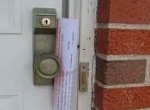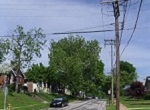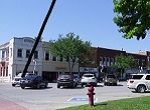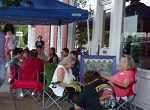Autumn Newsletter Ideas for Your Neighborhood
Last Updated: June 14, 2024
Continuing our series of articles to help editors write neighborhood print pieces or e-mail blasts, we are happy to list some autumn newsletter ideas that can be adapted to a particular homeowners association or community organization.
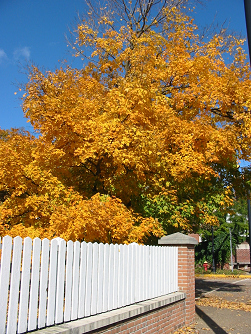
Sometimes this particular season brings new energy for community work, as people settle down from summer holidays and as children and students head back to school. Take advantage of that feeling that all things are possible by helping folks focus on what needs doing in your neighborhood. Often you should feature a mix of tips for individual property owner action and genuine community action and interaction.
If you're the editor, you probably already know this, but be sure to stay in sync with what your board and officers are trying to emphasize and achieve. Without further ado, let's delve into 11 autumn newsletter ideas, each of which could probably be divided into several stories or e-mails.
1. Write a story about the viewpoint of a particular person or business owner who is actively enjoying community work. Ask how the person became involved, what is attractive and interesting about the neighborhood, why community work holds a fascination for that person, and what lessons learned your interviewee can report. Don't always focus on the people who get the most press anyway; you may find a forgotten person who makes an important community event or service run quietly and efficiently in the background. If so, that is the best course. Make your readers feel like they are gaining something unique by opening your newsletter.
2. If you live where students are headed back to school, keep in mind that the adults too may be in a mood to be a little more serious about learning. Find experts in or near your community who can shed some light on what your neighborhood or community regards as its most important issue. Do an impartial interview and simply transcribe it word for word. Allow the person you interview to edit out anything that they didn't state accurately. Of course edit out any hesitations and awkward exchanges. If you find a true expert, this will make for good reading. Keep it fairly short though. Substitute depth for length.
If this story is a hit and causes lots of comment or debate, you could interview an expert who takes the opposite position for the next newsletter.
3. Ask the neighbors to share inspirational photos of good-looking communities or neighborhood features that they encountered in their summer travels. If a high proportion of your neighborhood is active on social media, you could request that these photos be shared there rather than sent to the newsletter editor. However, if you have low or inconsistent social media use, you could try to publish the photos the next month. Be sure to ask people who send photos to comment on why they found this particular neighborhood or feature attractive.
4. Find out what's new in local schools this year, and share that information. People who do not have school age children often are out of touch with school issues but yet pay property taxes to support the schools. Also perceived school quality impacts their property values. Probably a state or provincial government publishes some kind of ranking of schools, and you can dig into why your local schools received a particular rating.
If your newsletter often takes on the tone of cuteness, interview a few of the children about how they feel about going back to school. Or ask a leading question, such as what is the stinkiest thing at your school?
By the way, kids' art makes a great addition to an electronic newsletter, especially one that you are eager to have shared on social media. Proud mamas, papas, and grandparents will be glad to spread that cute drawing.
5. As usual, announce and promote upcoming events, including meetings, parties, festivals, clean-ups, back-to-school events and giveaways, and autumn and winter holiday events. As soon as you have a date for your winter holiday festivities, go ahead and announce the date and time, even if details such as the venue, cost, and registration requirements are not yet known.
You might even be big-hearted enough to announce events pertinent to the neighborhood next door or to the entire city.
If your own neighborhood has a signature event or festival of some type, try to find a unique angle, an untold story of behind the scenes preparation for it.
6. Autumn newsletter ideas might arise from thinking a few minutes about our history as agricultural people. Share how a particular locally raised vegetable or fruit that is abundant in autumn came to be such a staple in your community. Here is where you can get by with sharing recipes, if your neighborhood would appreciate that.
7. Promote your neighborhood social media heavily. Since this is a time of year when household routines often change, this is one of your two windows (the other one being New Year's) to ask people to Follow or Like you, or whatever you need. You may think that you are repeating the social media information way too often, but that's likely not the case. Give an example or several examples of the information that can be gained from your pages or the fun people will miss if they don't engage.
8. If autumn brings elections to your community, you might want to ask candidates to submit position statements. A better option probably is to ask them to answer questions that you consider important to the neighborhood. Feel free to ask for information about qualifications and history of previous community or school involvement.
If it's a hotly contested election where lots of information will be available anyway, an alternative is to ask a university professor or mediator to give tips for civil conversations with people who hold opposing views.
Another approach is to write an article about what a person elected to a particular job actually would do. What does a recorder of deeds do? If elected to the school board, when does it meet and how much time does it take? If choosing a mayor, does the mayor vote, have veto power, control the city council's agenda, or exactly what does that office entail other than showing up at ribbon cuttings?
9. If you think there is such a thing as fall house cleaning in your neighborhood, remind people of where they can donate or sell unused items. Rules about solid waste disposal in your community also are ripe for restatement.
10. With cooler weather on its way, encourage walking and cycling to get people outdoors to notice what is really going on in the community. If you think that most people are driving everywhere and not noticing what is happening, you might give them a scavenger hunt quiz and reward those who find instances of each item on your list. For example, you might ask people to find things such as a missing street sign, a sidewalk that needs to be repaired, a house with purple flowers in front, or whatever is relevant to your particular community. Maybe a local business would offer a small prize for each person who submits correct answers.
Actually it's just a lot simpler to say let's all walk at 10 a.m. every Saturday starting at Paul's Place. Have a walk leader on tap for each week, and ask each leader to plan a different route through the community. If you as the newsletter editor or contributor go on the first walk, we can just about guarantee you will come home with additional autumn newsletter ideas for your next issue.
If you live in a neighborhood where people don't feel safe walking, be sure to try the group walk. Seeing 10 or 12 people walking around is a subtle statement that some people in the neighborhood do care what happens. Also it gives the participants a sense of their own power to do something about public safety. This is equally true for situations in which neighbors are afraid of crime and situations in which neighbors fear speeding traffic in the face of no sidewalks.
11. Plant the seeds for next year's initiatives. If your board has decided to start a major project next year, write some background pieces for the next few newsletters to prepare the way. If your calendar, neighborhood association dues, or projects will change in the near future, begin to explain the rationale behind the revisions.
Autumn Newsletter Ideas Should Include Property Owner Suggestions
Autumn is a great time to use your newsletter to remind property owners of their responsibilities. And you can just suggest home owner maintenance that will be helpful to the owner in the long run. For instance you might try these, depending on the weather where you are:
- Describe how autumn leaves should be handled.
- Encourage pruning of vegetation or weather-proofing of plants and trees that is appropriate for your climate.
- Suggest how the home owner can tighten a building to prevent those pesky mice from seeking warmth indoors.
- Explain the phenomenon of ice dams on roofs, or of damage to driveways and patios from the freeze-thaw cycle, if those weather conditions are common where you are.
- If furnaces and fireplaces are needed in your location, ask the hardware store or a top-notch local contractor for recommendations about seasonal maintenance.
- Talk about preparing patio furniture, pools, spas, fire pits, and the like for winter.
- State the laws of your city or the rules of your HOA regarding certain kinds of nuisances. Autumn is a great time to plead for cleaning up of trash, debris, junk cars, falling fences, overgrown vegetation, or extra outdoor storage of any kind. Also be sure to emphasize small painting tasks, such as painting trim or sealing decks, that are commonly needed in your part of the world.
If you need more inspiration for autumn newsletter ideas or if you are new to the world of newsletter editing, be sure to see our general page on homeowner newsletters, linked below. From that page, you also can reach the pages we've written for the other three seasons of the year. Depending on your weather and circumstances, those pages will stimulate more ideas for you.
Related Pages to Stimulate Ideas for the Newsletter Editor
- Making and Keeping a Good Community >
- Community Organizations >
- Neighborhood and HOA Newsletters > Autumn Newsletter Ideas
Join GOOD COMMUNITY PLUS, which provides you monthly with short features or tips about timely topics for neighborhoods, towns and cities, community organizations, and rural or small town environments. Unsubscribe any time. Give it a try.
